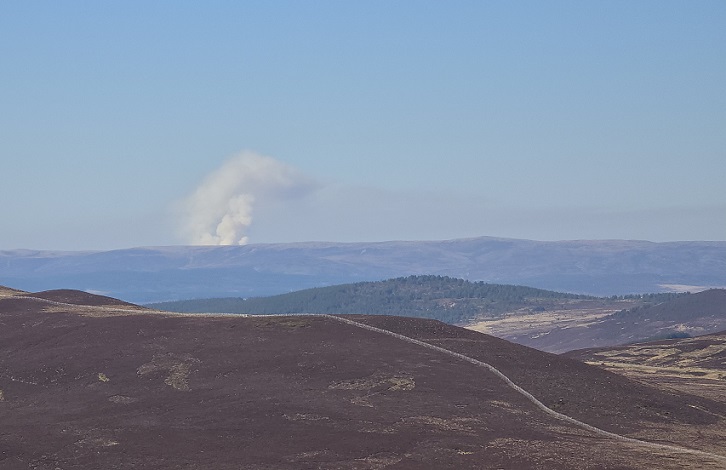
On 1st April the Scottish Fire and Rescue Service (FRS) issued a “Very High to Extreme” warning for the period 2nd till 7th April (see here). It advised the public “to avoid lighting fires outdoors across all areas of Scotland during this period.” The NASA global wildfire data base (see here) enables one to check the fires it recorded as taking place in this period.
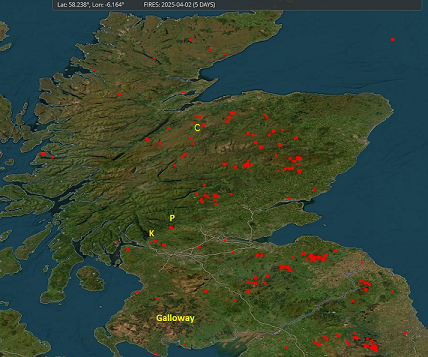
Anyone with a reasonable knowledge of land-use in Scotland will realise at once that the vast majority of these fires have been on grouse moors. A number of fires are recorded for the area north of Carrbridge (top photo). The map shows the extent to which sporting estates are ignoring SFRS’s advice and the voluntary provisions of the Moorland Code and are carrying on with muirburn regardless.
By zooming into the map you can see the fires reported in the media for the Kilpatrick Hill (see here) and Port of Menteith (see here). For some reason – presumably a technical glitch – the enormous fire in the Galloway Forest Park (see here) did not appear in my searches for 2nd – 6th April but did appear in a search for fires recorded in the the 24 hours up until 6th (when I started writing this post):
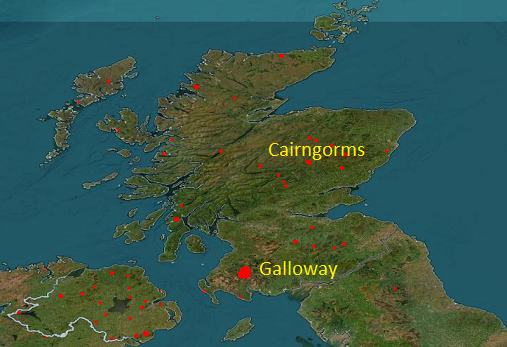
The political point – and everything about grouse moors is political – is the amount of muirburn that was undertaken over the weekend even after the evidence of what had happened in the Kilpatricks, near Port of Menteith and in Galloway, and despite the windy forecast. Using NASA and Andy Wightman’s database, Who Owns Scotland (see here), it is not difficult to identify the landowners who are responsible. For example, the cluster of fires on the bottom left of the map below are just north of the Spittal of Glenshee in the Cairngorms National Park: those to the west of the road (the A93) are on the Rhiedorrach Sporting Estate (see here) and the one on the east is on Invercauld (where the Cairngorms National Park Authority is currently funding peatland restoration):
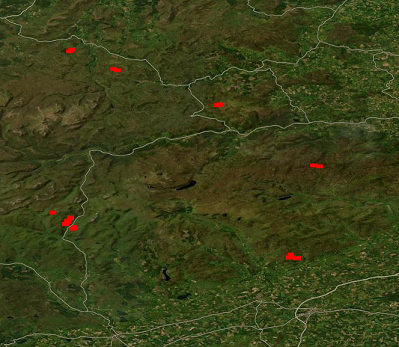
So why aren’t the public authorities with responsibility for preventing wildfire and controlling muirburn publicly calling on these landowners to do the right thing and stop burning? The short answer is these bodies have uncritically swallowed the line that the people who conduct muirburn are the wildfire experts (see here), turn a blind eye to all the evidence that indicates otherwise and focus their attention on campfires instead. The longer answer is our public authorities are not prepared to challenge the interests of sporting estate landowners, from King Charles downwards (see here). As a consequence estate staff can ignore advice on wildfire risk with impunity.
On estate staff competence, in the last few weeks I have learned of several examples of uncontrolled muirburn which have caused extensive damage BEFORE the current SFRS warning was issued.
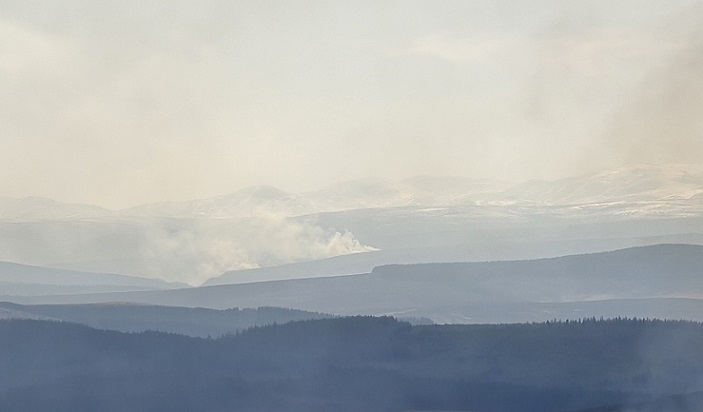
Just off Glen Banchor, near Newtonmore, a recent fire – attended I understand by only one person (three are advised under the Muirburn Code) – burned from the floor of the glen to the summit slopes (photo to be published in due course). Another was described in this comment on another parkswatch post:
“Last week Turret Estate above Crieff burnt a section of the west face of Coinachan Hill from just above the loch to near the summit. A really steep rocky hillside [contrary to muirburn code ed]. I could see the flames clearly from Crieff. My son was up there and said they were over 15ft high and out of control; noone could be seen attending it.”
It is scandalous that no-one in the Scottish Government, SFRS, NatureScot or the Cairngorms National Park appears to be documenting any of this (unlike campfires) or assembling evidence to counter the propaganda emanating from grouse moor interests. Section 12 of the Wildlife Management and Muirburn (Scotland) Act 2024 states that a “person intending to make muirburn on land to which the licence relates must complete a training course approved under section 13A before making muirburn”. Proof there is a problem! However, instead of stopping this my understanding is one of the justifications for the delay in the implementation of the muirburn provisions of the Act was to allow time for estate staff trained. The reckless and incompetent burning shows the right thing to have done would have been to introduce the provisions of the Act immediately and ban anyone from conducting muirburn until they had proved themselves competent and willing to abide by official advice.
NatureScot is currently consulting on a revised version of the Muirburn Code (see here). The content does not appear an improvement on the existing Code but, whatever its strengths and weaknesses (which I will consider in a further post), it will have no teeth because “the licensing approach will be delivered in line with the…… Principles of Better Regulation”. Those principles state that regulation will be “proportionate, consistent, accountable, transparent and targeted only where needed”. That ignores the scale of the problem. The evidence for muirburn – and other evidence like that for raptor persecution – shows that regulation of grouse moors and their activities needs to be comprehensive not targeted.
The updated warning from SFRS about the current very high fire risks on 7th April (see here) once again called on the general public to act responsibly without calling on landowners to do the same. Given this, and the silence from the Scottish Government, NatureScot and the CNPA about reckless burning by grouse moor owners, it should now be clear the revised Muirburn Code will make little difference, whatever it says. There is simply not the political will in government.

And as well as the fire risk, think of all the ground nesting birds. This is criminal. I hope the perpetrators are imprisoned.
Muir burn today on hillside east of A9 at Cuaich estate just E of Dalwhinnie
Why don’t the public, the authorities and the press pick up on all this ultra-high level incompetence? How is that only Nick Kempe seems able to put 2 & 2 and the technology together?!
Nick has developed substantial expert knowledge on these issues – he can also call on the knowledge and expertise of others. I have posted this and other Parkswatch articles on Twitter. More people need to do this. The mainstream media are not covering these issues – although Vicky Allan has done an excellent job of covering some specific issues, such as landslips. It’s seen as a niche issue, so social media and online publications are pretty much the only places where information can be shared. There is concern amongst the public (I’m one of them) – you need to tap into that concern, because there is a lot of ignorance of these issues and the The waste of money is chronic, the wasted opportunities are tragic. It all needs to be seen in the round.
Good point – but please also post on Bluesky so we can move away from the fascist’s X.
I’d like to know how many grouse were shot in Scotland last year and how many grouse there are on the moors now. I’ve walked the Angus glens and other grouse shooting areas in the east Highlands at different times of the year and seen or heard very few grouse. That’s despite the slaughter of an untold number of other animals and the burning over the years of a huge swathe of heather. My point is: does the number of birds killed and income generated justify the environmental damage caused?
What are your thoughts on this article? – ‘Limited spatial co-occurrence of wildfire and prescribed burning on moorlands in Scotland’ link = https://www.sciencedirect.com/science/article/pii/S0006320724002623#s0060
My family makes frequent use of Galloway Forest Park for cycling, so we know the areas where the wildfires have occurred. Most of the land is owned by Forestry and Land Scotland (the successor in Scotland to the FC), but I wonder if the fires are the result of muirburn on privately owned or leased land. Muirburn doesn’t seem to be a big thing in the area.
A very topical article Nick, which made a few questions spring to mind. Would be great if anyone could shed some light on these:
Has the Scottish Fire and Rescue Service gone on the record to say that its warnings about lighting fires include muirburn?
Do we knowthe extent to which muirburn is practised to create grazing for sheep or deer, rather than food for grouse, and whether this is on such a scale as to be a problem?
And finally, do we know how many out of control fires occur away from the main grouse moor areas? There has just been such a fire on the Inverpolly estate in Sutherland, a place with lots of deer, few sheep and no grouse shooting. Folk are blaming tourists but there is no evidence as yet of the cause.
Geraint, good questions, some of which I have tried to start to answer in post today and more of which I hope to cover in due course, Nick